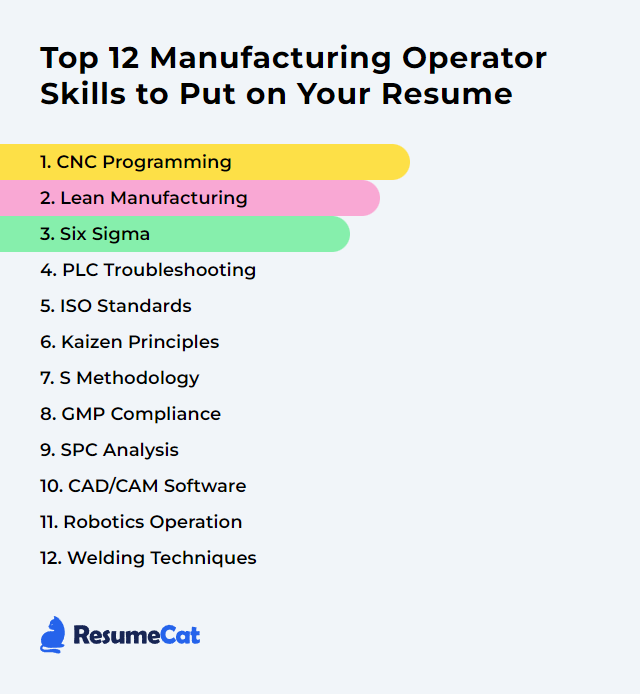Top 12 Manufacturing Operator Skills to Put on Your Resume
In today's job market, standing out as a manufacturing operator takes more than clocked hours and a steady hand. A sharp mix of technical and process skills signals you can run with change, keep lines humming, and drive quality without drama.
Manufacturing Operator Skills
- CNC Programming
- Lean Manufacturing
- Six Sigma
- PLC Troubleshooting
- ISO Standards
- Kaizen Principles
- 5S Methodology
- GMP Compliance
- SPC Analysis
- CAD/CAM Software
- Robotics Operation
- Welding Techniques
1. CNC Programming
CNC programming creates the instructions that tell machines how to cut, drill, and shape material. Done right, parts come off the line accurate, repeatable, and fast.
Why It's Important
It puts precision on autopilot. Accuracy rises, waste drops, and throughput climbs. That’s money, quality, and schedule control in one move.
How to Improve CNC Programming Skills
Know your machine: Understand travel limits, spindle speeds, workholding, and control quirks (Haas, Fanuc, Siemens—each has a personality).
Simulate first: Use CAM and verification tools (e.g., Fusion 360, Mastercam) to catch crashes, gouges, and air cuts before chips fly.
Standardize code: Create templates, consistent tool naming, and notes. Fewer surprises, cleaner revisions. Reference reliable G/M-code guides.
Optimize toolpaths: High-efficiency milling, rest machining, and adaptive strategies save time and tools.
Keep learning: Courses on CNC and manufacturing tech from places like Coursera or LinkedIn Learning keep you current.
Maintain and calibrate: A well-aligned machine makes any program look better. Use trusted references like Machinery’s Handbook for setup checks.
Use operator feedback: The person at the machine sees the real-world hiccups. Fold their input into revision cycles.
How to Display CNC Programming Skills on Your Resume

2. Lean Manufacturing
Lean focuses on removing waste and boosting flow so value reaches the customer with less friction and fewer delays. For operators, it means smart motions, clean setups, and steady quality.
Why It's Important
It trims costs, slashes defects, and speeds delivery. Less firefighting. More predictable output.
How to Improve Lean Manufacturing Skills
Practice continuous improvement: Small daily wins beat rare big projects. Capture and act on ideas quickly.
Apply 5S: Sort, Set in order, Shine, Standardize, Sustain. A tidy cell runs faster and safer.
Map value streams: Visualize material and information flow. Remove stalls and loops that add no value.
Use Just-In-Time: Make what’s needed, when needed—reduce WIP, shorten lead times.
Go to the root cause: 5 Whys, cause-and-effect diagrams—fix the cause, not the symptom.
Standard work: Lock in the best-known method, then improve it.
Engage everyone: Operators see waste first. Invite, test, and reward suggestions.
How to Display Lean Manufacturing Skills on Your Resume
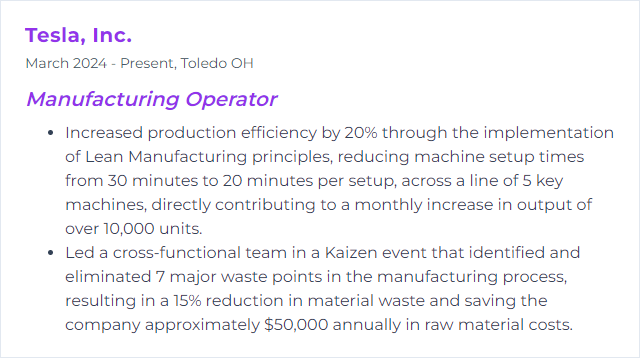
3. Six Sigma
Six Sigma uses data to hunt down variation, squeeze out defects, and lock in dependable processes.
Why It's Important
Fewer defects, happier customers, better margins. And the process becomes teachable, scalable, auditable.
How to Improve Six Sigma Skills
Learn the language: Concepts, roles, and belt levels. ASQ and similar groups offer solid foundations.
Run DMAIC: Define, Measure, Analyze, Improve, Control. Follow the roadmap, don’t skip the hard steps.
Use the right tools: SPC charts, capability analysis, Pareto, FMEA, and root-cause methods.
Analyze with software: Tools like Minitab make stats approachable and repeatable.
Document controls: Sustain gains with control plans, standard work, and visible metrics.
Keep sharpening: Certifications, practice projects, coaching from experienced practitioners.
How to Display Six Sigma Skills on Your Resume

4. PLC Troubleshooting
PLC troubleshooting means diagnosing and fixing control-system issues so automation runs as intended—safely, consistently, and on time.
Why It's Important
Downtime is expensive. Quick, methodical troubleshooting gets lines back up and keeps scrap and delays from snowballing.
How to Improve PLC Troubleshooting Skills
Master the basics: I/O types, scan cycles, addressing, and common fault states.
Know your platform: Rockwell, Siemens, Omron, Mitsubishi—study the manuals, hardware, and software tools you actually use.
Read ladder logic: And function block or structured text if your plant uses them. Trace signals from input to output.
Be systematic: Power first, then comms, then I/O status, then program logic. Change one thing at a time.
Use diagnostics: Built-in status bits, trend tools, and force functions—collect evidence before acting.
Practice safely: Lockout/tagout, simulate when possible, and verify before energizing outputs.
How to Display PLC Troubleshooting Skills on Your Resume

5. ISO Standards
ISO standards set common, globally recognized expectations for quality, safety, and consistency. They anchor procedures, records, and results to clear requirements.
Why It's Important
They make quality repeatable. They open doors to new markets. They align teams on what “good” looks like and how to prove it.
How to Improve ISO Standards Skills
Train on relevant standards: ISO 9001 for quality, ISO 14001 for environment, ISO 45001 for safety—know what applies.
Tighten processes: Translate requirements into simple, usable procedures and work instructions.
Audit regularly: Internal audits surface gaps early. Treat findings as improvement fuel, not blame.
Close the loop: Use corrective and preventive actions with root-cause discipline.
Keep current: Track updates to standards and revise documentation without delay.
How to Display ISO Standards Skills on Your Resume
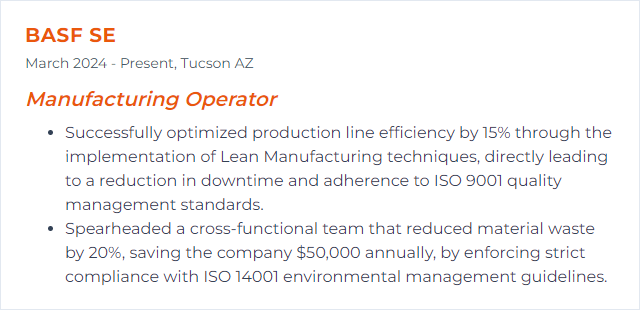
6. Kaizen Principles
Kaizen is continuous improvement—small, steady changes that compound into big gains. Everyone participates. Every day counts.
Why It's Important
It reduces waste, shortens cycles, and boosts morale. Problems get solved closer to where they appear.
How to Improve Kaizen Principles Skills
Standardize first: Lock in the current best method so improvements can be measured.
Use visual management: Labels, shadow boards, color coding, andons—make status obvious.
Empower operators: Give time and tools for ideas. Test quickly. Share results openly.
Apply 5S: A clean, organized space makes problems visible and fixes easier.
Solve root causes: Use structured problem solving and verify the fix holds.
Eliminate waste: Attack defects, overproduction, waiting, motion, transport, overprocessing, and inventory.
Keep learning: Short, frequent training and kaizen events keep momentum alive.
How to Display Kaizen Principles Skills on Your Resume

7. 5S Methodology
5S is a hands-on system for workplace order: Sort, Set in order, Shine, Standardize, Sustain. Less clutter, fewer errors, faster work.
Why It's Important
It improves safety, speeds setups, and makes abnormalities jump out. Flow gets smoother. Downtime shrinks.
How to Improve 5S Methodology Skills
Run real 5S events: Start with a pilot area, measure before-and-after, then expand.
Make it visual: Floor markings, bin labels, tool outlines, color standards—no guesswork.
Standardize cleaning: Daily checklists, clear ownership, timed tasks.
Audit lightly but often: Short audits keep standards alive without bogging the team down.
Coach behaviors: Tools help, habits sustain. Praise adherence, correct drift early.
How to Display 5S Methodology Skills on Your Resume

8. GMP Compliance
GMP (Good Manufacturing Practice) keeps regulated products—like pharmaceuticals, medical devices, and foods—consistently safe and effective. It’s procedure-driven, documentation-heavy, and essential.
Why It's Important
It protects patients and consumers, satisfies regulators, and prevents costly recalls. Precision in process and records isn’t optional.
How to Improve GMP Compliance Skills
Know the rules: Understand the applicable GMP regulations for your industry and region (FDA, EMA, etc.).
Train continuously: Refresher training, practical scenarios, and clear SOP reviews. Organizations like ISPE offer strong programs.
Control the environment: Cleanliness, contamination control, and proper gowning where required. Follow proven hygiene and disinfection practices.
Document meticulously: If it isn’t written, it didn’t happen. Control versions and maintain traceability.
Audit and improve: Internal audits, deviation tracking, CAPAs, and effectiveness checks.
Maintain equipment: Qualification, calibration, and preventive maintenance on schedule.
How to Display GMP Compliance Skills on Your Resume

9. SPC Analysis
Statistical Process Control tracks process behavior with data. Control charts signal when to act and when to leave a stable process alone.
Why It's Important
It prevents defects instead of sorting them out later. Variation is seen early, adjusted quickly, and quality holds steady.
How to Improve SPC Analysis Skills
Train on fundamentals: Control limits, common vs. special cause, capability indices.
Choose the right charts: X-bar/R, I-MR, p, np—match the chart to the data type.
Collect clean data: Calibrated gauges, clear sampling plans, disciplined entry.
Use capable tools: Software like Minitab or plant SPC systems (e.g., InfinityQS) for real-time signals.
Investigate signals: Pair SPC with root-cause tools such as Ishikawa diagrams and 5 Whys.
Standardize responses: Define what to do when a point goes out of control—no hesitation.
How to Display SPC Analysis Skills on Your Resume
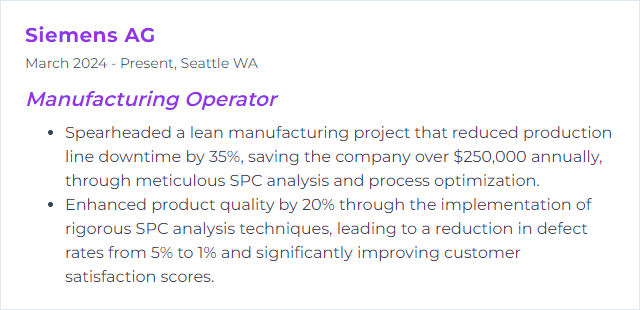
10. CAD/CAM Software
CAD/CAM links design to machining. You model the part, generate toolpaths, simulate, and send clean code to the machine.
Why It's Important
It increases precision, shortens programming time, and reduces scrap. Designs hit the floor ready to run.
How to Improve CAD/CAM Software Skills
Learn the workflow: Import models, define stock, set coordinates, create operations, post, verify.
Master modeling basics: Constraints, sketches, assemblies, and design-for-manufacture decisions.
Use templates and libraries: Standard tools, holders, feeds/speeds, and setup sheets speed programming.
Refine toolpath strategy: Adaptive clearing, stepovers, stepdowns, cutter engagement—balance speed with tool life.
Simulate relentlessly: Check collisions, retracts, fixture clearances, and cycle times before posting code.
Dial in post-processors: Match control requirements (codes, canned cycles) to the machine on the floor.
Keep current: Follow releases for tools like Fusion 360, Mastercam, SOLIDWORKS CAM, or Siemens NX and practice new features.
How to Display CAD/CAM Software Skills on Your Resume
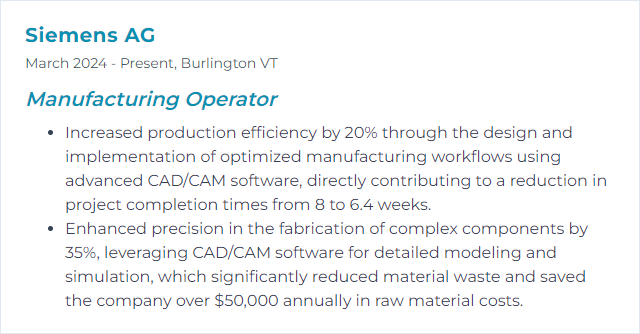
11. Robotics Operation
Robotics operation means setting up, teaching, and tending robots and automated cells so they work safely and hit targets shift after shift.
Why It's Important
Robots bring speed, consistency, and safer work. Repetitive or risky tasks move off human hands, quality stabilizes, and output scales.
How to Improve Robotics Operation Skills
Maintain on schedule: Grease points, inspect cables, check torque and calibration. Preventive beats reactive.
Train deeply: Teach pendant skills, safe zones, payload limits, and recovery procedures. A3 (Association for Advancing Automation) publishes helpful guidance.
Update software: Apply vendor updates to improve performance and reliability. Validate changes in a test environment first.
Optimize the process: Review reach, approach angles, gripper design, and cycle balance. Trim non-value robot motions.
Leverage data: Monitor cycle times, faults, and motor loads to predict failures and tune performance.
Prioritize safety: Risk assessments, light curtains, cobot speeds, and clear procedures—no shortcuts.
How to Display Robotics Operation Skills on Your Resume
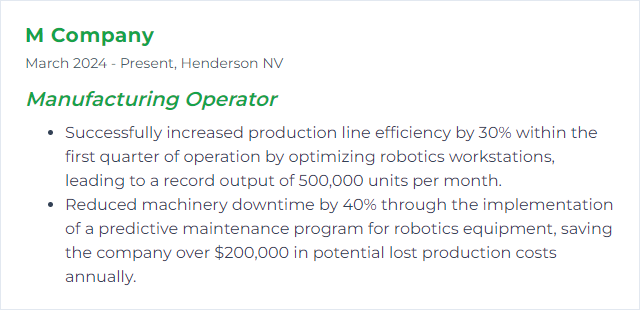
12. Welding Techniques
Welding joins metals by melting and fusing. MIG, TIG, and Stick each have strengths across materials, thicknesses, and applications.
Why It's Important
Strong, clean welds drive product performance and safety. Good technique cuts rework and keeps production flowing.
How to Improve Welding Techniques Skills
Nail the fundamentals: Joint prep, torch angles, travel speed, heat control, and shielding gas selection.
Work safely: PPE, ventilation, fire watch, and sound housekeeping. Safety first, always.
Practice with intent: Short, frequent sessions on varied positions and materials. Review beads, adjust, repeat.
Seek coaching: Courses, AWS-aligned training, and feedback from seasoned welders accelerate improvement.
Stay current: New wires, processes, and machines arrive fast—read, watch, experiment.
Use quality gear: Reliable power sources, correct consumables, and calibrated settings matter.
Inspect your work: Visual checks, bend tests, and NDT where needed—verify before it ships.
How to Display Welding Techniques Skills on Your Resume

